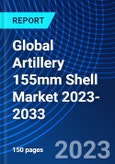The 155mm artillery shell is a large-caliber ammunition utilized in heavy artillery guns. Typically constructed from steel and filled with high explosives, these shells can also be adapted for other purposes like delivering chemical weapons or producing smoke. They consist of four main components: primer, propellant, fuse, and projectile. With a weight of approximately 100 pounds and a height of about 2 feet, the 155mm shell lives up to its name, as it possesses a diameter of 155mm.155mm Artillery Ammunition is a Crucial Component of Modern Artillery Systems, Offering Versatility, Lethality, and Strategic Impact on the Battlefield
The effective range of a 155mm artillery shell depends on various factors, such as the type of shell, gun, and propellant used. Generally, it can reach a maximum range of about 20 miles, but this can be extended with special propellants.
The versatility and cost-effectiveness of 155mm shells have made them indispensable in military forces worldwide. These shells come in various types, each designed for specific purposes. The most common type is the high-explosive (HE) shell, used for destroying enemy targets. Additionally, there are incendiary shells for starting fires, smoke shells for obscuring the battlefield, chemical shells for delivering toxic agents, and guided shells equipped with guidance systems for precision strikes on unseen targets.
In the modern battlefield, 155mm artillery ammunition remains crucial. Advancements in technology, such as guided shells and programmable munitions, show promise in enhancing their effectiveness further. Guided shells offer accurate indirect fire support, while programmable munitions can be timed or targeted for specific purposes, like area denial.
Recent conflicts, such as the Russia-Ukraine conflict, have seen significant usage of 155mm shells. The demand for these shells is driven by emerging markets seeking to upgrade their artillery systems and new technological developments, like range-extending and precision-guided technologies.
Technological advancements, such as base bleed and rocket-assisted propulsion, have contributed to the growth of the 155mm artillery shell market. Base bleed involves creating a gas cloud behind the shell to slow it down, allowing it to travel farther. On the other hand, rocket-assisted propulsion uses small rockets to increase initial velocity, leading to longer-range and more accurate hits.
As technology continues to progress, the market for artillery ammunition is expected to witness more innovation and improved capabilities. Geopolitical factors in Europe and the Asia-Pacific region will also influence procurement decisions. The market analysis includes factors like market size, trends, obstacles, and opportunities, with regional breakdowns.
In the market, the high-explosive segment is the largest, accounting for the majority of usage due to its common application in combat. Meanwhile, the extended range segment is experiencing rapid growth due to the rising demand for longer-range shells.
Recent developments include substantial contracts for Rheinmetall, driven by the need to replenish ammunition stocks during the Ukraine conflict. The German Bundeswehr has placed significant orders for various types of artillery ammunition, reflecting the continued importance of 155mm shells in modern warfare.
Table of Contents
155MM Artillery Shell Market Report DefinitionExpert Opinions on 155MM Artillery Shell Market ReportConclusions
155MM Artillery Shell Market Segmentation
155MM Artillery Shell Market Analysis for next 10 Years
Market Technologies of 155MM Artillery Shell Market
Global 155MM Artillery Shell Market Forecast
Regional 155MM Artillery Shell Market Trends & Forecast
Country Analysis of 155MM Artillery Shell Market
Opportunity Matrix for 155MM Artillery Shell Market
Table Information
| Report Attribute | Details |
|---|---|
| No. of Pages | 150 |
| Published | September 2023 |
| Forecast Period | 2023 - 2033 |
| Estimated Market Value ( USD | $ 3.58 Billion |
| Forecasted Market Value ( USD | $ 4.89 Billion |
| Compound Annual Growth Rate | 2.8% |
| Regions Covered | Global |









